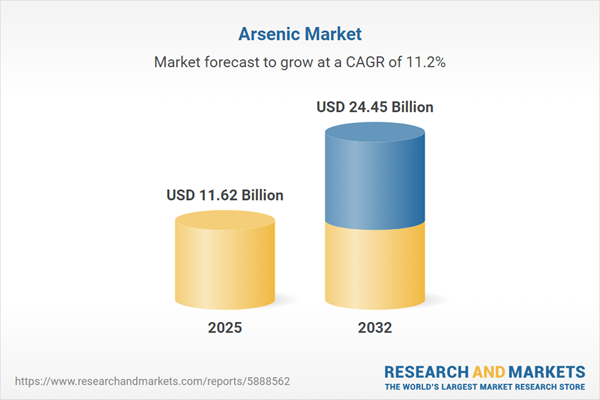Speak directly to the analyst to clarify any post sales queries you may have.
Arsenic plays a pivotal role in global industry, cutting across sectors such as semiconductors, agriculture, and chemical manufacturing, while also demanding responsible management due to its toxicity and complex regulatory requirements. Senior executives must navigate evolving market conditions, technology trends, and compliance measures to optimize opportunities and minimize risks.
Market Snapshot: Growth Trajectory of the Arsenic Market
The arsenic market is expanding steadily, advancing from USD 10.46 billion in 2024 to USD 11.62 billion in 2025. Sustained momentum is anticipated through 2032, driven by a compound annual growth rate (CAGR) of 11.19% and culminating in a projected valuation of USD 24.45 billion. This growth reflects increased application in critical end-use industries, ongoing regulatory adaptation, and innovation in remediation and detection technologies.
Scope & Segmentation: Strategic Overview of Arsenic Market Dynamics
- Form: Segmentations include pentoxide, trioxide, and trisulfide compounds, each essential for specific processes and optimized performance.
- Grade: Market is divided by laboratory reagent grade, pharmaceutical grade, and technical grade materials, supporting precise application in fields from advanced manufacturing to life sciences.
- Application: Core use areas span agricultural pesticides, electronic semiconductors (including PCB etching and semiconductor doping), glass manufacturing, metal processing, and wood preservation.
- End Use Industry: Key sectors encompass agriculture, chemical industry, electronics, metallurgy, pharmaceuticals, and wood treatment industries.
- Distribution Channel: The distribution model covers direct sales, global and regional distributors, and emerging online sales platforms, ensuring adaptability to market needs.
- Geographic Regions: Coverage extends across the Americas (North America and Latin America), Europe, Middle East & Africa (including Western and developing markets), and the Asia-Pacific region (notably electronics and wood preservation markets).
- Leading Companies: Industry participants include Hebei Yuxing Chemical Technology Co., Ltd., Anhui Tongling Dadian Fine Chemical Co., Ltd., Shanxi Xisheng Fine Chemical Co., Ltd., Solvay S.A., ICL Group Ltd., China National Chemical Corporation, The Chemours Company, Orbia Advances Corporation, S.A.B. de C.V., Sinochem Group Co., Ltd., and FMC Corporation.
Key Takeaways for Senior Decision-Makers
- Arsenic compounds balance industrial utility and regulatory scrutiny; careful product selection and process upgrades remain crucial due to ongoing toxicological concerns.
- Technological advances in remediation, such as bioremediation and high-precision detection, are enabling more effective contamination controls and competitive positioning.
- Strategic supply chain diversification, responsive to policy or trade changes, supports operational resilience and cost stability, particularly amid fluctuating feedstock availability.
- Consumer and regulatory push toward sustainability is accelerating investments in purification, circular economy initiatives, and adoption of greener processes.
- Innovation pipelines, including process intensification and digital monitoring, are increasingly differentiating leading suppliers as the market evolves toward traceability and transparency.
United States Tariff Impact: Adjusting Import and Domestic Value Chains
Recent tariffs in the United States have altered both sourcing strategies and domestic supplier partnerships, prompting shifts toward local production and strategic inventory buffers. Niche sectors reliant on high-purity imports experienced short-term constraints, emphasizing the importance of risk assessment and adaptive procurement frameworks in mitigating disruption within the arsenic supply chain.
Strategic Methodology & Data Sources
This research leverages a mixed-methods methodology, including direct interviews with regulatory, engineering, and executive stakeholders. Secondary validation is drawn from academic journals, industry reports, and market databases. The analytical framework triangulates market segmentation by form, grade, application, and distribution, supplemented by qualitative insights into regulatory and market sentiment trends.
Why This Report Matters to Industry Leaders
- Comprehensive segmentation unveils high-value opportunities and risk points across products, applications, and regions for optimized strategic planning.
- Actionable guidance equips executives with the intelligence to enhance operational efficiency, ensure regulatory alignment, and foster sustainable growth in dynamic end-use sectors.
- In-depth coverage of innovation and supply chain adaptation informs investment and partnership decisions in a rapidly evolving market landscape.
Conclusion
As regulatory demands and technological expectations continue to evolve, industry players will find that informed strategies anchored in diversification, compliance, and sustainability will drive sustained value and resilience in arsenic markets. This report provides a critical roadmap for navigating sector complexity, enabling proactive, data-driven leadership.
Additional Product Information:
- Purchase of this report includes 1 year online access with quarterly updates.
- This report can be updated on request. Please contact our Customer Experience team using the Ask a Question widget on our website.
Table of Contents
3. Executive Summary
4. Market Overview
7. Cumulative Impact of Artificial Intelligence 2025
Companies Mentioned
The companies profiled in this Arsenic market report include:- Hebei Yuxing Chemical Technology Co., Ltd.
- Anhui Tongling Dadian Fine Chemical Co., Ltd.
- Shanxi Xisheng Fine Chemical Co., Ltd.
- Solvay S.A.
- ICL Group Ltd.
- China National Chemical Corporation
- The Chemours Company
- Orbia Advances Corporation, S.A.B. de C.V.
- Sinochem Group Co., Ltd.
- FMC Corporation
Table Information
| Report Attribute | Details |
|---|---|
| No. of Pages | 187 |
| Published | October 2025 |
| Forecast Period | 2025 - 2032 |
| Estimated Market Value ( USD | $ 11.62 Billion |
| Forecasted Market Value ( USD | $ 24.45 Billion |
| Compound Annual Growth Rate | 11.1% |
| Regions Covered | Global |
| No. of Companies Mentioned | 11 |









